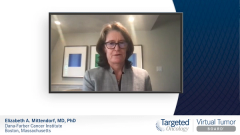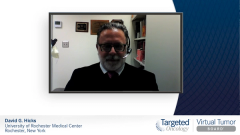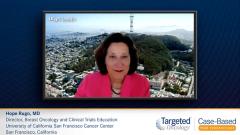
Case 3: 48-Year-Old Woman With Stage T2N1 TNBC
Elizabeth Mittendorf, MD, PhD, and Ruta Rao, MD, present the case of a 48-year-old woman with stage T2N1 TNBC.
Episodes in this series

Elizabeth A. Mittendorf, MD, PhD: I will move on to the third case. I’m going to present the case, and then before we do the discussion route, we’ll let Ruta present the slides. Then we’ll get into the discussion. Our third patient is also young. She is a 48-year-old with a T2N1 triple-negative breast cancer. She receives dose-dense AC [doxorubicin hydrochloride, cyclophosphamide] followed by paclitaxel, and then underwent mastectomy and lymph node dissection. She also had residual disease: 1.4 cm of tumor in the breast tissue and negative axillary lymph nodes. She received adjuvant capecitabine. Unfortunately, about 9 months or so later, she had chest wall recurrence. Scanning showed what appeared to be liver lesions and mediastinal adenopathy.
The team did a biopsy, which confirmed metastatic triple-negative breast cancer. PD-L1 testing was performed. Genetic testing did not show. The PD-L1 testing showed that her IC [information coefficient] score was greater than 1. They did the SP142 test. She didn’t carry a mutation. She was treated in accordance with KEYNOTE-355, I think because of the short interval between her first line of treatment in the neoadjuvant setting in this recurrence. She got carboplatin, gemcitabine, and pembrolizumab.
Ruta, as you suggested, there was a consideration for that first patient. Then 8 months later, she progressed. It’s also noted that she has some neuropathy. Gosh, there are about 50 questions we could ask about this case. But we’ve had a nice advance in an approval, in the last year or so, for triple-negative breast cancer that may impact the treatment recommendations for this patient. Ruta, you can go through the slides that you have.
Ruta Rao, MD: Sure. What we’re going to talk about regarding this patient is the drug sacituzumab govitecan [Trodelvy]. This was approved based on a phase 3 trial called ASCENT. These were patients who had received 2 or more lines of chemotherapy for their advanced or metastatic triple-negative breast cancer. There were 529 patients on the trial. They were randomized in a 1:1 fashion to either sacituzumab—which was given on day 1 and 8, every 21 days—or to the treatment of a physician’s choice. Those drugs could have been capecitabine, eribulin, vinorelbine, or gemcitabine—what we would have picked in somebody who had previously received an anthracycline or a taxane. These are very reasonable choices as the treatment of a physician’s choice.
These patients were continued on treatment until there was progression or unacceptable toxicity, with a primary end point of progression-free survival. Actually, this trial was halted early because of compelling evidence of efficacy based on unanimous DSMC [Data and Safety Monitoring Committee] recommendations. In this trial, the median progression-free survival was improved from 1.7 months for the patients who had treatment of physician’s choice to 5.6 months for those who received sacituzumab. This was a hazard ratio of 0.51 [Actual hazard ratio values from Bardia A et al. 2020 are 0.41]. The overall survival went from 6.7 months to 12.1 months with a hazard ratio of 0.48—a significant improvement in both.
In addition—something we’re looking for— these patients oftentimes have a significant burden of liver or lung disease, or wherever their volume of disease is. We also want to get a response. The response rate for sacituzumab in this trial was 35%, compared to 5% for treatment of physician’s choice. Remember, response is identified as complete response and partial response. If we then look at the clinical benefit rate, which takes into account the patients who had stable disease in addition to those who responded, the clinical benefit rate went from 9% for treatment of physician’s choice to 45%. So 45% of these patients have a meaningful response. For patients who have multiple lines of prior therapy, this is really significant.
Elizabeth A. Mittendorf, MD, PhD: All right. Thanks. What that just demonstrated is why we should have the medical oncologist reviewing the slides from the clinical trial. That was very nice. Thank you.
Transcript edited for clarity.












































